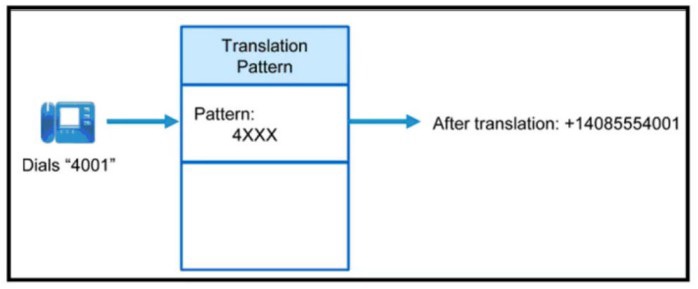
- Email support@dumps4free.com

A customer routes PSTN calls to ITSP through a SIP trunk on Cisco UCM that forwards and receives calls to and from ITSP. ITSP is set to send an E.164 number when the customer's extension is four digits. Which action should be taken to route the incoming calls to four-digit extensions?
A.
Configure a voice translation rule to map the E.164 number to four digits and assign it to the incoming dial-peer on Cisco Unified Border Element.
B.
Set the Significant Digits to 4 on the SIP trunk.
C.
Configure a voice translation profile to map the E.164 number to four digits and assign it to the incoming dial-peer on Cisco Unified Border Element.
D.
Set the Significant Digits to 8 on the SIP trunk.
E.
Configure a voice translation rule to map the E.164 number to four digits and assign it to the incoming dial-peer on Cisco Unified Border Element.
F.
Set the Significant Digits to 4 on the SIP trunk.
G.
Configure a voice translation profile to map the E.164 number to four digits and assign it to the incoming dial-peer on Cisco Unified Border Element.
H.
Set the Significant Digits to 8 on the SIP trunk.
Set the Significant Digits to 4 on the SIP trunk.
Refer to the exhibit.
A company needs to ensure that all calls are normalized to E164 format. Which
configuration will ensure that the resulting digit string 14085554001 is created and will be routed to the E.164 routing schema?
A.
Called Party Transformation Mask of + 14085554XXX
B.
Called Party Transformation Mask of 1408555[35)XXX
C.
Calling Party Transformation Mask of +1408555XXXX
D.
Calling Party Transformation Mask of +14085554XXX
Called Party Transformation Mask of + 14085554XXX
Which IOS command creates a SIP-enabled dial peer?
A.
voice dial-peer 20 sip
B.
dial-peer voice 20 voip
C.
dial-peer voice 20 pots
D.
dial peer voice 20 sip
dial-peer voice 20 voip
Reference: https://www.ciscopress.com/articles/article.asp?p=664148&seqNum=6
A company has an SRST gateway running an IOS XE image. The company plans to enable the IPv6 addressing companywide. To enable the IPv6 in a unified SRST gateway to support SIP phones, what are two supported supplementary features for an IPv6 fallback scenario? (Choose two.)
A.
three-way conference
B.
secure SIP lines
C.
T.38 fax relay
D.
transcoding
E.
SIP trunk
three-way conference
T.38 fax relay
Reference:
https://www.cisco.com/c/en/us/td/docs/voice_ip_comm/cusrst/admin/sccp_sip_srst/configur
ation/ guide/SCCP_and_SIP_SRST_Admin_Guide/srst_sip_isr4000.html
Cisco SIP IP telephony is implemented on two floors of your company. Afterward, users report intermittent voice issues in calls established between floors. All calls are established, and sometimes they work well, but sometimes there is one-way audio or no audio. You determine that there is a firewall between the floors, and the administrator reports that it is allowing SIP signaling and UDP ports from 20000 to 22000 bidirectionally. What are two possible solutions? (Choose two.)
A.
Go to the SIP profile assigned to these IP phones in Cisco Unified CM and change the range of media ports to 16384-32767
B.
Ask the firewall administrator to change the ports to TCP.
C.
Ask the firewall administrator to change the range of UDP ports to 16384-32767.
D.
Go to the SIP profile assigned to these IP phones in Cisco Unified CM and change the range of media ports to 20000-22000.
E.
Go to System Parameters in Cisco Unified Communications Manager and change the range of media ports to 20000-22000.
Go to the SIP profile assigned to these IP phones in Cisco Unified CM and change the range of media ports to 16384-32767
Ask the firewall administrator to change the range of UDP ports to 16384-32767.
Reference: https://www.cisco.com/c/en/us/td/docs/voice_ip_comm/cucm/port/9_1_1/
CUCM_BK_T2CA6EDE_00_tcp-port-usage-guide-91/CUCM_BK_T2CA6EDE_00_tcp-portusage-
guide- 91_chapter_01.html
| Page 3 out of 24 Pages |
| Previous |